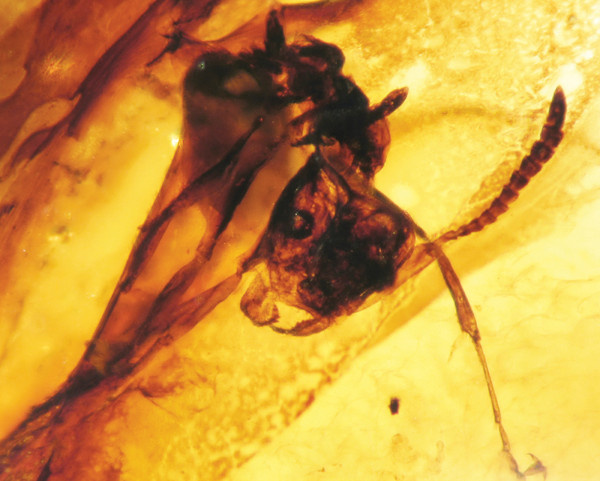
by Mary Caperton Morton Monday, January 5, 2015

Insects preserved in amber can't be used to reengineer dinosaurs, but they can reveal details of Mesozoic habitats. Credit: University of Alberta Strickland Entomology Museum specimen, R.C. McKellar.
In the movie “Jurassic Park,” dinosaurs were resurrected from DNA in blood harvested from Mesozoic mosquitoes preserved in amber. The plot was pure science fiction, but a new study has found another use for the biological material trapped in fossilized tree resin. By studying microscopic inclusions of plant material, pollen and feathers preserved in bits of amber recovered alongside dinosaur fossils, paleontologist Ryan McKellar of the Royal Saskatchewan Museum in Canada is recreating a more complete picture of the Mesozoic landscape.
“Basically it puts a backdrop to these dinosaur digs, it tells us a bit about the habitat,” McKellar said in a statement. The amber can reveal details such as what kinds of plants and insects were abundant, and what the atmosphere was like at the time the amber was formed. For example, the study, presented at the 2014 Geological Society of America Annual Meeting in Vancouver, B.C., details the discovery of an aphid coated in amber, found stuck to fossilized remains of a duck-billed dinosaur. The insect can’t be used to build a new duckbill, but it can reveal information about the evolution of insects and their ecological relationship to dinosaurs. “When you get insects, it is like frosting on the cake — you can really round out the view of the ecosystem,” McKellar said.
McKellar uses tiny bits of friable amber — found in conjunction with fossil-rich bone beds — which crumbles more readily than the familiar jewelry-grade variety of amber. Working with friable amber was difficult until recently, but McKellar’s technique reduces crumbling by vacuum-injecting the amber with epoxy. Friable amber is widespread across North America and commonly found in association with coal and bone beds.
© 2008-2021. All rights reserved. Any copying, redistribution or retransmission of any of the contents of this service without the expressed written permission of the American Geosciences Institute is expressly prohibited. Click here for all copyright requests.